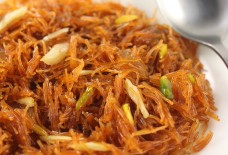Za’atar: The Queen of Spice
Image source wander-crush.comBY: Nisreen Eadeh/Staff Writer
Eaten in the Arab world for centuries, za’atar has a special history as the Queen of Spice. For hundreds of years, Arabs have been mixing together sesame, sumac, salt, and wild oregano and thyme to create za’atar, making it one of the oldest blends in the world.
Evidence of za’atar’s age appears in Ancient Egypt. Pharaoh Tutankhamun, also known as “King Tut”, was buried with an ancient version of za’atar called saem, which contained an abundance of thyme. In both the Old and New Testaments, za’atar makes an appearance as a sacred ingredient to be sprinkled on the foods of God’s servants. By the first century CE, Pliny the Elder, the Roman author and naturalist, discovered that za’atar was used as perfume by kings.
Za’atar’s history as a royal ingredient used by society’s greatest powers gives it the nickname, Queen of Spice. Thyme and oregano, plants native to the Levant, give za’atar its alluring flavor that captivates people all over the world today.
For Arabs everywhere, za’atar is most commonly used as a dip with pita and olive oil (zeit wo za’atar), but its consumption goes beyond breakfast time. Za’atar can be used as meat and seafood marinade, sprinkled on salads and hummus, layered onto flatbread, paired with vinaigrette in salad dressing, or blended into tea and coffee. It’s best used as a finishing spice that can offer a last minute burst of flavor to a variety foods.
Za’atar mixed with oil, labneh, and pita from The Lemon Bowl Za’atar chicken from scarpetta Roasted vegetable pilaf with za’atar from Healthy Food UKFrom its holy roots to the modern era, za’atar provokes nostalgia and happiness, both figuratively and literally. A study published in May 2013 found that “when administered orally to rats, carvacrol (oregano and thyme essential oils) affected levels of the neurotransmitters dopamine — which plays a key role in the brain’s rewards system — and serotonin, which is important to learning and mood.”
Throughout history, za’atar has been used to improve memory, promote healthy brain functioning, and improve moods. In today’s age of science, researchers are finding that these theories are true. While there is disagreement on the extent of the health benefits, all can agree that za’atar is a healthy food to have around.
Aside from releasing serotonin, the main ingredients of za’atar – sumac, thyme, and oregano – are natural antioxidants that help to protect cells from damage. Some scientists believe za’atar can temporarily improve cognition, as well. Traditionally, Arab children will be sure to eat za’atar before taking a test at school because they believe it increases cognitive speed and brain functions. So far, researches have found this effect in lab animals, but only minimal effects in humans.
What has been proven is that za’atar is an anti-fungal and anti-inflammatory agent. In the Middle Ages, doctors used za’atar to help fight cancer swelling and regulate patients’ moods and sleep cycles.
This savory combination not only kicks up the flavor, but the brain power, too. Even if only minimal, the health benefits associated with za’atar puts this spice blend at the top of the chain, reigning queen over the rest.



